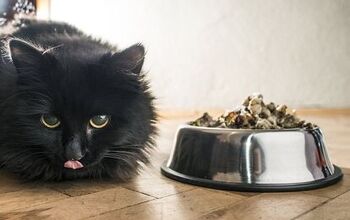Should I Feed My Cat Wet or Dry Food?

If you’ve ever stood in the pet food aisle trying to choose between cans and kibble, you’re not alone. One of the most common questions cat owners face is whether wet or dry food is better - and the answer isn’t one-size-fits-all. Both options offer their own benefits and drawbacks, and the best choice often depends on your cat’s specific needs, preferences, and lifestyle.
Here’s what to know when deciding what to put in your cat’s bowl.
Wet vs. Dry: What’s the Real Difference?
Both wet and dry cat foods can provide complete and balanced nutrition, as long as they meet standards set by reputable veterinary organizations like the Association of American Feed Control Officials (AAFCO). The key difference between them is moisture content. Wet food contains around 70–80% water, while dry food has about 10% - making wet food a great source of hydration.
This is especially important because many cats naturally have a low thirst drive. Descended from desert-dwelling animals, cats often don’t drink as much water as they should. Feeding wet food can help prevent dehydration and may support urinary and kidney health, particularly in older or more sensitive cats.
Dry food, on the other hand, is more calorie-dense. Cats eat less of it but take in more energy per bite. That can be a plus for very active cats, but it may contribute to weight gain in indoor or less active pets. Dry food is also convenient, shelf-stable, and easy to store - making it a practical choice for busy households or those with multiple cats.
But What About Dental Health?
You may have heard that dry food is better for your cat’s teeth. While the crunch can help reduce tartar buildup slightly, it’s not a substitute for actual dental care. Unless the kibble is specifically designed for dental health, the effect is minimal. Wet food, meanwhile, doesn’t offer any abrasive benefit - but either way, regular brushing and vet checkups remain the gold standard for feline oral hygiene.
Convenience, Cost, and Taste
Dry food wins hands down when it comes to convenience. It’s less expensive per serving, easier to store, and can be left out throughout the day for free-feeding (if your cat can be trusted not to overdo it). Wet food, on the other hand, needs to be refrigerated after opening and should be eaten shortly after being served to avoid spoilage.
However, wet food has an edge when it comes to taste and texture. It’s usually more aromatic and appealing, especially to picky eaters, older cats, or those with dental issues. Many cats simply enjoy the soft texture and richer flavor of canned food.
What About Medical Conditions?
Some cats may benefit from one type of food over the other for health reasons. Cats with kidney disease or chronic urinary issues often do better with wet food because the extra moisture supports kidney function and helps dilute the urine. Cats with diabetes or obesity might require a vet-prescribed diet (wet or dry) depending on their unique nutritional needs.
Always talk to your veterinarian if your cat has any ongoing health concerns. They can guide you toward the best food choice (or combination) for your pet’s condition.
Verdict: Is a Mix of the Two the Best Option?
For many households, a mixed feeding routine works best. Offering both wet and dry food can give your cat the hydration and flavor they crave, along with the convenience and cost-efficiency of dry kibble.
Some owners serve wet food in the morning and dry in the evening, while others mix a little wet food into dry for added variety.
As long as you’re not overfeeding, this balanced approach can keep mealtimes interesting and help ensure your cat stays healthy and happy.

A proud mama to seven dogs and ten cats, Angela spends her days writing for her fellow pet parents and pampering her furballs, all of whom are rescues. When she's not gushing over her adorable cats or playing with her dogs, she can be found curled up with a good fantasy book.
More by Angela Vuckovic

























